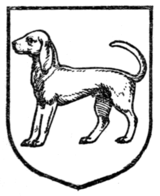The pegasus (Figs. 365 and 366), though often met with as a crest or found in use as a supporter, is very unusual as a charge upon an escutcheon. It will be found, however, in the arms of the Society of the Inner Temple and in the arms of Richardson, which afford an example of a pegasus rampant and also an example in the crest of a pegasus sejant, which at present is the only one which exists in British heraldry.
Fig. 367 gives a solitary instance of a mare. The arms, which are from Grünenberg's Wappenbuch (1483), are attributed to "Herr von Frouberg from the Forest in Bavaria," and are: Gules, a mare rampant argent, bridled sable.
The ass is not a popular charge, but the family of Mainwaring have an ass's head for a crest.
DOGS
Dogs will be found of various kinds in many English and Scottish coats of arms, though more frequently in the former than in the latter. The original English dog, the hound of early days, is, of course, the talbot (Figs. 368, 369, 370, and 371). Under the heading of sup-






